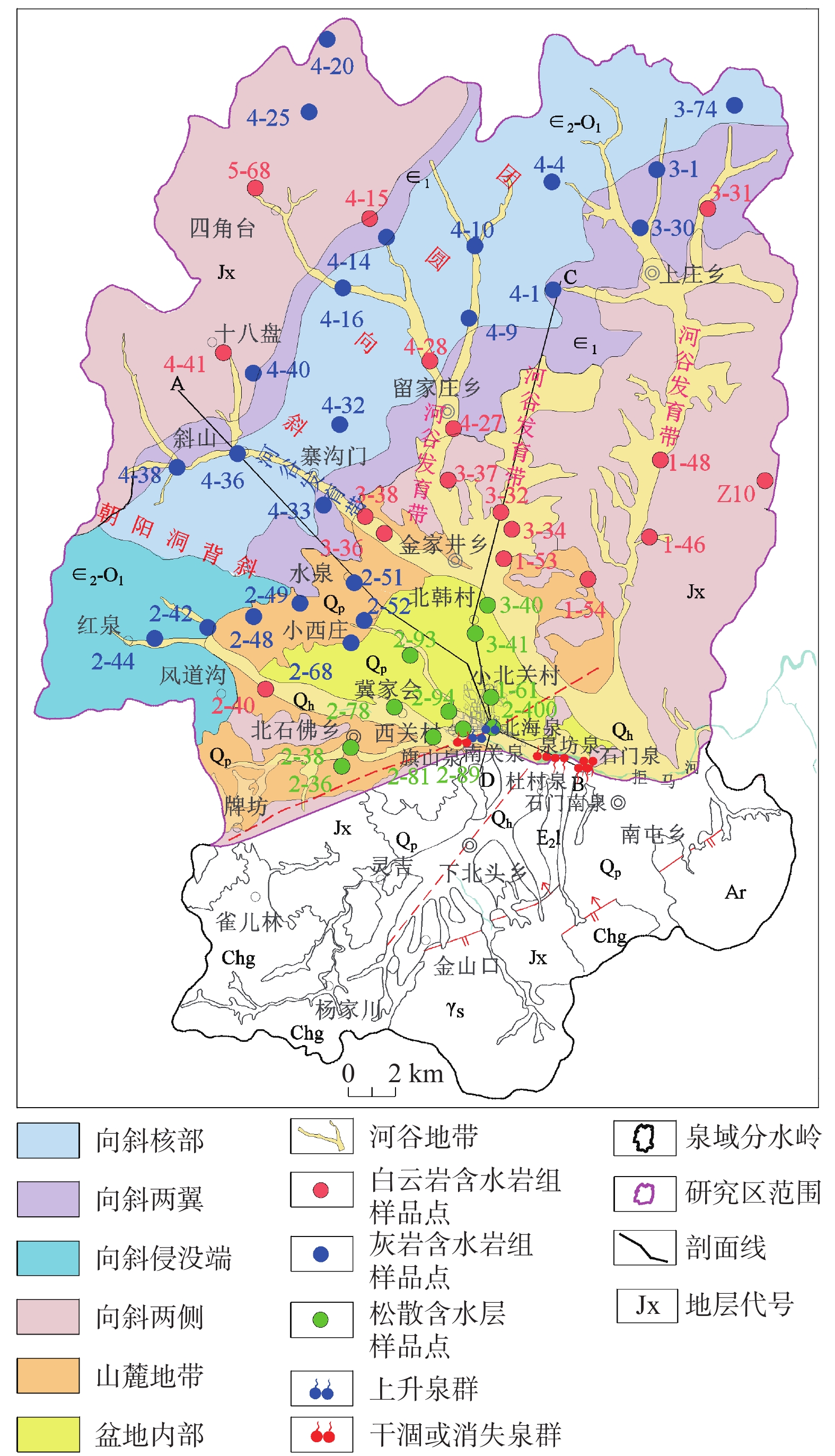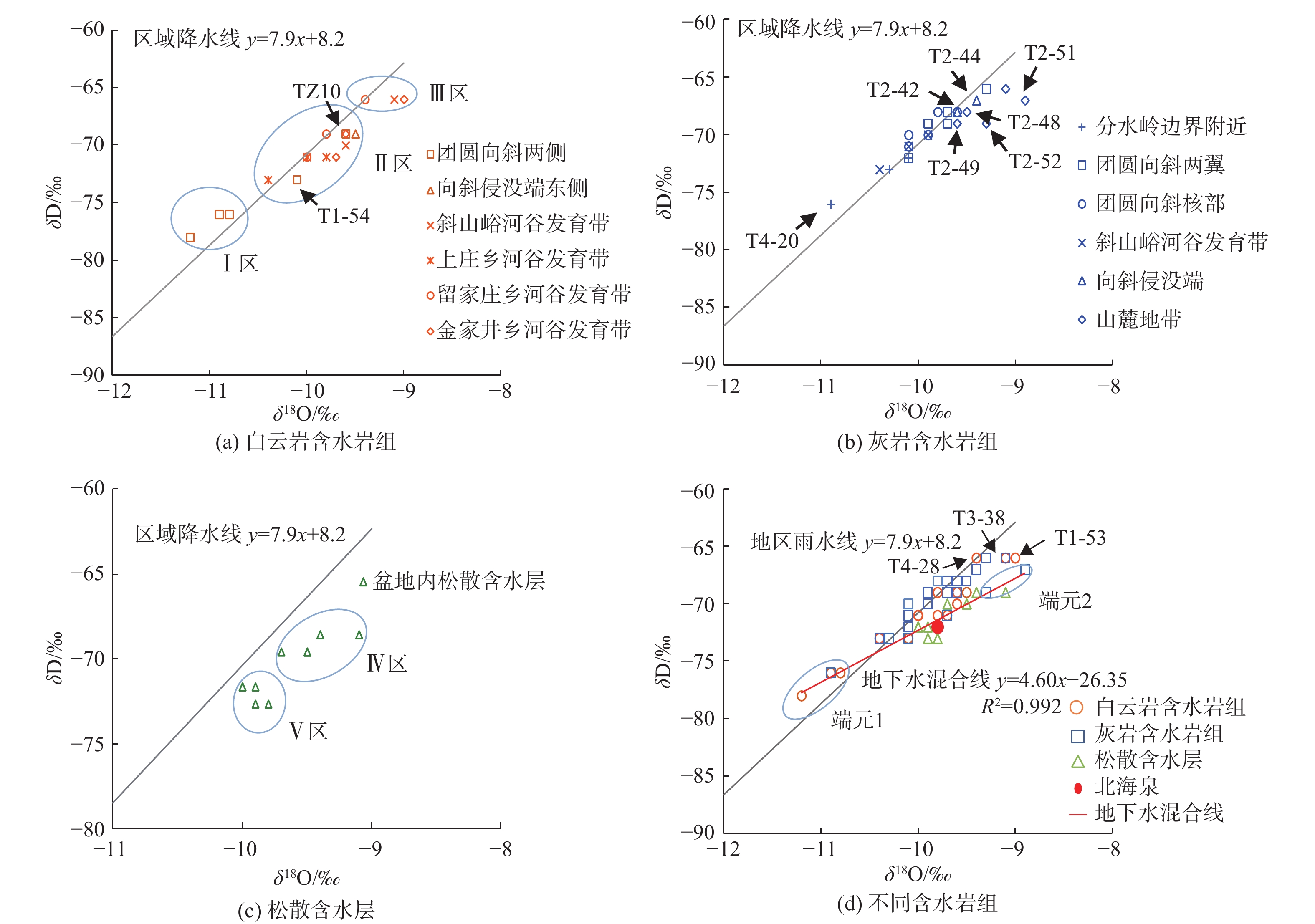Characteristics of hydrogen and oxygen isotopes in the groundwater and formation mode of the Beihai springs in the northern Laiyuan Basin
-
摘要:
拒马源泉群作为拒马河的源头,受到了较多专家和学者的关注。但这些研究多集中在地下水的水化学、水位动态、泉流量等特征上,对地下水氢氧同位素特征的分析几乎没有,且对北海泉的成因解释多为粗略的定性概述。为了说明涞源北盆地地下水的氢氧同位素特征,详细揭示北海泉的形成模式,首次系统地采集了不同含水岩组的地下水样品,测定了水样的氢氧同位素组分。结果表明:样品点δD和δ18O值均落在区域大气降水线上或附近,大气降水是研究区地下水的主要补给来源;白云岩、灰岩含水岩组高程效应较明显,径流途径长,松散含水层径流途径短,受蒸发作用较强;白云岩、灰岩含水岩组和松散含水层氘盈余d值分别为6.0‰~11.6‰、4.2‰~11.2‰、3.8‰~8.0‰,较大气降水大部分偏小,表明岩溶水和松散孔隙水经历了不同的流动过程;白云岩、灰岩含水岩组从补给区向排泄区各自流动过程中,在小西庄、香炉屯村附近断裂带发生沟通混合,然后在向盆地中心径流过程中受断层阻水上升,上升过程中又接受了松散孔隙水的补给,最后在松散岩层中出露成泉,形成北海泉。在孔隙水混入前,两者的平均补给比例大约为48.4%~57.6%和42.4%~51.6%。
Abstract:As the source of the Jumahe River, the Juma springs has received the attention of many experts and scholars. Previous studies focused mainly on the chemical and dynamic characteristics of the groundwater and the spring discharge characteristics, the hydrogen and oxygen isotopes characteristics were seldom examined, and the explanation of the causes of the Beihai springs was only a rough qualitative overview. To illustrate the characteristics of hydrogen and oxygen isotopes of the groundwater in the northern Laiyuan Basin and reveal the forming mode of the Beihai springs in detail, groundwater samples in different aquifers were systematically collected for the first time in the study are area and the hydrogen and oxygen isotopic components were determined in this paper. The results show that the values of δD and δ18O in the water samples fall on or near the regional meteoric water line, indicating that the meteoric water is the main recharge source of the groundwater. The altitude effect is obvious and the groundwater flow path is long for the groundwater in the dolomite aquifer and limestone aquifer, the groundwater flow path is short and the evaporation effect is strong for the groundwater in the unconsolidated sediment aquifer. The deuterium excess of the sample in the dolomite aquifer, limestone aquifer and unconsolidated sediment aquifer are 6.0‰−11.6‰, 4.2‰−11.2‰ and 3.8‰−8.0‰, respectively, much smaller than that in the meteoric water, showing that the karst water and the pore water undergo different processes. When the groundwater in the dolomite aquifer and limestone aquifer flows from the recharge areas to the discharge areas, hydraulic connection and mixing occur in the fault zone near Xiaoxizhuang and Xianglutun. Groundwater rises during the process of flow to the center of the basin because of the resistance effect of the fault, and groundwater in the dolomite aquifer and limestone aquifer is subsequently recharged by the pore water in the unconsolidated sediment aquifer, at last the groundwater emerges on the ground surface in the form of springs as the Beihai springs. Before the pore water joins in, the average recharge comes from the limestone aquifer and dolostone aquifer is about 48.4%−57.6% and 42.4%−51.6%, respectively.
-

-
表 1 涞源北盆地样品氢氧同位素特征
Table 1. Analytical results of hydrogen and oxygen isotopes of the groundwater samples
样品编号 采样地点 含水岩组 构造或地貌部位 井深/m 水温/℃ δD/‰ δ18O/‰ 氘盈余值d/‰ d平均值/‰ 含水岩组 构造部位 T5-68 四角台村 白云岩含水岩组 团圆向斜两侧 泉点 8 −78 −11.2 11.6 8.5 9.8 T4-15 陈家庄村 12 9 −76 −10.8 10.4 T4-41 十八盘村西 180 9 −76 −10.9 11.2 T1-54 泉峪村 120 8 −73 −10.1 7.8 TZ10 石棉三矿 160 8 −69 −9.6 7.8 T2-40 白绸村北 向斜侵没端东侧 240 8 −69 −9.5 7.0 7.0 T3-38 北坡底村 斜山峪河谷发育带 200 10 −66 −9.1 6.8 6.8 T3-36 土巷口村北 184 8 −70 −9.6 6.8 T1-48 中庄村 上庄乡河谷发育带 160 9 −71 −10.0 9.0 8.9 T1-46 狮子峪 85 10 −73 −10.4 10.2 T3-31 上老芳村南 305 9 −71 −9.8 7.4 T4-28 坡水村东 留家庄乡河谷发育带 195 8 −66 −9.4 9.2 9.2 T4-27 留家庄村 216 10 −69 −9.8 9.4 T3-37 张家铺村 220 9 −71 −10.0 9.0 T3-32 岳家庄村 金家井乡河谷发育带 150 9 −71 −9.7 6.6 6.8 T3-34 王家井村 150 10 −69 −9.6 7.8 T1-53 梁家庄村 160 10 −66 −9.0 6.0 T4-20 分水岭村 灰岩含水岩组 分水岭边界附近 泉点 6 −76 −10.9 11.2 8.8 9.8 T4-25 嗅水盆村中 17.4 8 −73 −10.3 9.4 T3-74 谷家庄北 泉点 6 −72 −10.1 8.8 T4-40 东沟村西南 团圆向斜两翼 6.6 11 −66 −9.3 8.4 9.1 T4-14 马圈沟村 30 10 −69 −9.9 10.2 T3-1 沙岭村北 160 10 −72 −10.1 8.8 T4-1 南庄村西 165 9 −68 −9.7 9.6 T3-30 东泉头村 220 10 −69 −9.7 8.6 T4-10 石片村东北 团圆向斜核部 60 8 −71 −10.1 9.8 9.8 T4-9 团圆村西南 85 7 −70 −10.1 10.8 T4-32 任家沟村 105 9 −68 −9.6 8.8 T4-16 水石塘村西 195 8 −70 −9.9 9.2 T4-4 窑子沟村西 泉点 9 −68 −9.8 10.4 T4-33 南坡底村西北 斜山峪河谷发育带 180 7 −70 −9.9 9.2 9.7 T4-36 斜山村南 90 9 −71 −10.1 9.8 T4-38 黄土岭村西 180 8 −73 −10.4 10.2 T2-42 艾河村西北 向斜侵没端 140 8 −68 −9.6 8.8 8.5 T2-44 红泉村东 180 7 −67 −9.4 8.2 T2-49 龙虎寺村西北 山麓地带 155 8 −69 −9.6 7.8 6.4 T2-68 北上屯村东北 190 9 −66 −9.1 6.8 T2-52 香炉屯村南 200 11 −69 −9.3 5.4 T2-51 水泉村东 220 9 −67 −8.9 4.2 T2-48 赵家井村中 180 8 −68 −9.5 8.0 T2-93 沿村 松散含水层 盆地内 40 9 −73 −9.8 5.4 6.4 7.0 T2-81 西关加油站 20 11 −72 −10.0 8.0 T2-78 冀家会村 120 12 −72 −10.0 8.0 T2-36 南石佛村 150 9 −73 −9.9 6.2 T2-38 北石佛村 134 10 −72 −9.9 7.2 T3-41 顾家营村 108 12 −69 −9.4 6.2 5.9 T3-40 北韩村 200 13 −70 −9.5 6.0 T1-61 小北关村 100 11 −70 −9.5 6.0 T2-94 西环沿村 32 10 −69 −9.1 3.8 T2-89 西关村 10 9 −70 −9.7 7.6 T2-400 拒马源公园 断裂带附近 泉点 12 −72 −9.8 6.4 6.4 6.4 -
[1] 吴兴礼, 齐宗汉, 戴国梓, 等. 中国北方岩溶地下水资源及大水矿区岩溶水的预测、利用与管理的研究[R]. 石家庄: 河北省地质矿产局第一水文地质工程地质大队, 1988.
WU Xingli, QI Zonghan, DAI Guozi, et al. Research on forecast, utilization and management of karst groundwater resources in north China and karst groundwater in the abundant water mining area[R]. Shijiazhuang: The First Institute of Hydrogeology and Engineering Geology of Hebei Bureau of Geology and Mineral Resources Exploration, 1988. (in Chinese)
[2] 杨旭东, 马学军, 李伟. 涞源县拒马源泉群地质遗迹保护和开发利用评价报告[R]. 保定: 中国地质调查局水文地质环境地质调查中心, 2007.
YANG Xudong, MA Xuejun, LI Wei. Protection, development and utilization of Juma spring groups geological relics in Laiyuan[R]. Baoding: Center for Hydrogeology and Environmental Geology, 2007. (in Chinese)
[3] 李玉龙, 朱小龙, 谷明旭, 等. 涞源盆地地下水动态特征分析[J]. 科技传播,2013,5(11):108 − 109. [LI Yulong, ZHU Xiaolong, GU Mingxu, et al. Analysis of groundwater dynamic feature in the Laiyuan Basin[J]. Public Communication of Science & Technology,2013,5(11):108 − 109. (in Chinese with English abstract)
[4] 贾春义. 涞源泉域岩溶水化学研究[J]. 勘察科学技术,1996(1):24 − 29. [JIA Chunyi. Karst water chemistry study in Laiyuan spring field[J]. Site Investigation Science and Technology,1996(1):24 − 29. (in Chinese with English abstract)
[5] 李志先. 利用降水量推算涞源泉流量方法的探讨[J]. 水文地质工程地质,1984(2):48 − 50. [LI Zhixian. Disseussion on caleurlation methods of spring volume by using the precipitation data[J]. Hydrogeology & Engineering Geology,1984(2):48 − 50. (in Chinese)
[6] 王海宁, 乔光建. 涞源岩溶地下水系统泉水量变化特征分析[J]. 南水北调与水利科技, 2011, 9(6): 54−57.
WANG Hainig, QIAO Guangjian. Variations of spring volume of the karst groundwater system in the Laiyuan Region[J]. South-to-North Water Diversion and Water Science & Technology, 2011, 9(6): 54−57.(in Chinese with English abstract)
[7] 马剑飞, 李伟, 刘蕴, 等. 涞源盆地地下水化学演化特征初步分析[J]. 南水北调与水利科技, 2014, 12(5): 141−146.
MA Jianfei, LI Wei, LIU Yun, et al. Preliminary analysis of groundwater chemistry evolution in Laiyuan basin[J]. South-to-North Water Transfers and Water Science & Technology, 2014, 12(5): 141−146. (in Chinese with English abstract)
[8] 王新峰, 刘蕴, 李伟, 等. 涞源盆地水文地质特征及缺水现状分析[J]. 南水北调与水利科技, 2012, 10(6): 74−78.
WANG Xinfeng, LIU Yun, LI Wei, et al. Analysis of hydrogeological conditions and water shortage status in the Laiyuan basin[J]. South-to-North Water Diversion and Water Science & Technology, 2012, 10(6): 74−78. (in Chinese with English abstract)
[9] 朱平, 李景豪, 陈佰太. 河北省涞源盆地遥感图像断裂构造解译及水文地质意义分析[R]. 保定: 地质部水文地质工程地质技术方法研究所, 1981.
ZHU Ping, LI Jinghao, CHEN Baitai. Interpret linear structures of remote sensing image and analysis hydrogeological significance in the Laiyuan Basin[R]. Baoding: Institute of Hydrogeology and Engineering Geology Techniyues, 1981. (in Chinese)
[10] 郑淑蕙, 侯发高, 倪葆龄. 我国大气降水的氢氧稳定同位素研究[J]. 科学通报, 1983, 28(13): 801−806.
ZHENG Shuhui, HOU Fagao, NI Baoling. Research on Stable Hydrogen and Oxygen Isotopes of Atmospheric Precipitation in my country [J]. Chinese Science Bulletin, 1983, 28(13): 801−806. (in Chinese)
[11] GREMILLION P, WANIELISTA M. Effects of evaporative enrichment on the stable isotope hydrology of a central Florida (USA) river[J]. Hydrological Processes,2000,14(8):1465 − 1484. doi: 10.1002/1099-1085(20000615)14:8<1465::AID-HYP987>3.0.CO;2-6
[12] 袁建飞. 广东沿海地热系统水文地球化学研究[D]. 武汉: 中国地质大学(武汉), 2013: 61−65.
YUAN Jianfei. Hydrogeochemistry of the geothermal systems in coastal areas of Guangdong Province, South China[D]. Wuhan: China University of Geosciences (Wuhan), 2013: 61−65. (in Chinese with English abstract)
[13] 魏静文. 华北平原地下水与地表水的水文地球化学及氢氧同位素特征分析[D]. 北京: 中国地质大学(北京), 2012: 28−29.
WEI Jingwen. Analysis of hydrogeochemistry and stable isotopes of surface water and groundwater in North China Plain[D]. Beijing: China University of Geosciences (Beijing), 2012: 28−29. (in Chinese with English abstract)
[14] 侯光才, 苏小四, 林学钰, 等. 鄂尔多斯白垩系地下水盆地天然水体环境同位素组成及其水循环意义[J]. 吉林大学学报(地球科学版),2007,37(2):255 − 260. [HOU Guangcai, SU Xiaosi, LIN Xueyu, et al. Environmental isotopic composition of natural water in Ordos Cretaceous Groundwater Basin and its significance for hydrological cycle[J]. Journal of Jilin University(Earth Science Edition),2007,37(2):255 − 260. (in Chinese with English abstract)
[15] 柳富田. 基于同位素技术的鄂尔多斯白垩系盆地北区地下水循环及水化学演化规律研究[D]. 长春: 吉林大学, 2008: 46−47.
LIU Futian. Research on groundwater circulation and hydrochemical transport in the northern part of Ordos Cretaceous Basin based on isotope technology[D]. Changchun: Jilin University, 2008: 46−47. (in Chinese with English abstract)
[16] MARFIA A M, KRISHNAMURTHY R V, ATEKWANA E A, et al. Isotopic and geochemical evolution of ground and surface waters in a karst dominated geological setting: a case study from Belize, Central America[J]. Applied Geochemistry,2004,19(6):937 − 946. doi: 10.1016/j.apgeochem.2003.10.013
[17] FRIEDMAN I, SMITH G I, GLEASON J D, et al. Stable isotope composition of waters in southeastern California: Modern precipitation[J]. Journal of Geophysical Research Atmospheres,1992,97(5):5795 − 5812. doi: 10.1029/92JD00184
[18] 张之淦. 同位素水文地质概论(油印本)[M]. 1984.
ZHANG Zhigan. Introduction to Isotope Hydrogeology(Mimeo) [M]. 1984. (in Chinese)
[19] 王东升, 徐乃安. 中国同位素水文地质学之进展[M]. 天津: 天津大学出版社, 1993: 5−11.
WANG Dongsheng, XU Nai'an. The progress of isotope hydrogeology in China[M]. Tianjin: Tianjin University Press, 1993: 5−11. (in Chinese)
[20] 刘存富, 王恒纯. 环境同位素水文地质学基础(选修课教材)[M]. 1984.
LIU Cunfu, WANG Hengchun. Environmental isotopic general hydrogeology (textbook for optional course) [M]. 1984. (in Chinese)
[21] 尹观, 倪师军. 地下水氘过量参数的演化[J]. 矿物岩石地球化学通报,2001,20(4):409 − 411. [YIN Guan, NI Shijun. Deuterium excess parameter evolution in ground water[J]. Bulletin of Mineralogy, Petrology and Geochemistry,2001,20(4):409 − 411. (in Chinese with English abstract) doi: 10.3969/j.issn.1007-2802.2001.04.057
[22] Mebus A G, 顾慰祖, 刘涌, 等. 阿拉善高原地下水的稳定同位素异常[J]. 水科学进展,1998,9(4):333 − 337. [Mebus A G, GU Weizu, LIU Yong, et al. Isotopically anomalous groundwater of Alxa plateau, Inner Mongolia[J]. Advances water Sciences,1998,9(4):333 − 337. (in Chinese with English abstract)
[23] 晁念英, 王佩仪, 刘存富, 等. 河北平原地下水氘过量参数特征[J]. 中国岩溶,2004,23(4):335 − 338. [CHAO Nianying, WANG Peiyi, LIU Cunfu, et al. Characteristic of deuterium excess parameter of groundwater in Hebei plain[J]. Carsologica Sinica,2004,23(4):335 − 338. (in Chinese with English abstract) doi: 10.3969/j.issn.1001-4810.2004.04.013
[24] 蒲俊兵. 重庆岩溶地下水氢氧稳定同位素地球化学特征[J]. 地球学报, 2013, 34(6): 713−722.
PU Junbing. Hydrogen and oxygen isotope geochemistry of karst groundwater in Chongqing[J]. Acta Geoscientica Sinica, 2013, 34(6): 713−722. (in Chinese with English abstract)
[25] 宋献方, 刘相超, 夏军, 等. 基于环境同位素技术的怀沙河流域地表水和地下水转化关系研究[J]. 中国科学(D辑: 地球科学),2007,37(1):102 − 110. [SONG Xianfang, LIU Xiangchao, XIA Jun, et al. A study of interaction between surface water and ground-water using environmental isotope in Huaisha River basin[J]. Science in China (Series D: Earth Sciences),2007,37(1):102 − 110. (in Chinese with English abstract)
[26] 宋献方, 李发东, 于静洁, 等. 基于氢氧同位素与水化学的潮白河流域地下水水循环特征[J]. 地理研究,2007,26(1):11 − 21. [SONG Xianfang, LI Fadong, YU Jingjie, et al. Characteristics of groundwater cycle using deuterium, oxygen-18 and hydrochemistry in Chaobai River Basin[J]. Geographical Research,2007,26(1):11 − 21. (in Chinese with English abstract) doi: 10.3321/j.issn:1000-0585.2007.01.002
[27] Mebus A G, GU W Z, LIU Y, et al. Isotopically anomalous groudwater of Alxa Plateau, Inner Mongolia[J]. Advances in Water Science,1998,9(4):333 − 337.
-




 下载:
下载:

